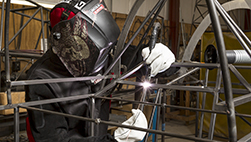 Welding hasn’t changed in decades or welding hasn’t changed at all. That’s what you hear from veteran practitioners. Many of them have been using the same oxy acetylene or tungsten inert gas (TIG) equipment for decades, and have seen no need to change. But the industry has not been static: there has been a steady stream of innovations and new products.
Welding hasn’t changed in decades or welding hasn’t changed at all. That’s what you hear from veteran practitioners. Many of them have been using the same oxy acetylene or tungsten inert gas (TIG) equipment for decades, and have seen no need to change. But the industry has not been static: there has been a steady stream of innovations and new products.
Change probably occurs at a faster pace in more high-volume, production scenarios. Automated welding, once properly set up, can all but guarantee the quality and the repeatability of welds on a job. Military contractors are using friction stir welding, which doesn’t require any kind of torch. It generates heat by the high-speed spinning of a cylindrically shaped tool.
For lower-volume applications like aircraft maintenance, automated welding probably would be the exception to the rule. Welders use manual TIG, metal inert gas (MIG) or oxy acetylene torches, all of which have been available for many years.
Although oxy acetylene is the process that is tested for in the Federal Aviation Administration (FAA) exam for candidate airframe and powerplant (A&P) mechanics, the TIG process is generally viewed as relatively more advanced. For one thing, TIG is more controllable in real time. As an electrical process, TIG has benefited from advances in the manipulation of electrical current—such as wave shaping and high-frequency switching—that help to fine-tune characteristics of the arc such as the heat output, cleaning vs. penetration, arc stability and directional control for difficult-to-weld materials such as aluminum, titanium and magnesium.
The technologies are very different. TIG uses an electrical arc to create heat and shields the weld puddle with inert argon gas. With oxy acetylene, the welder ignites acetylene gas with a handheld striker and feeds the acetylene with oxygen to create a high-temperature flame. The acetylene flame melts the metal with the intense heat of the inner cone, approximately 5,600 degrees F, and then shields the molten puddle with the flame’s outer envelope until cooled. Oxy acetylene is also a dirtier process, as the burning acetylene creates carbon soot if the right mixture is not achieved, says Dave Duhon, a recently retired welder with a major airline.
Oxy acetylene is better for cutting and brazing than for welding, says Ray Bacon, an instructor at the A&P school within Tarrant County College in Fort Worth, Texas. “It takes a lot of heat for a gas flame to make steel molten, and the heat spreads too far, so you wind up really heating up your work and could punch a hole in it or distort it.” More modern techniques concentrate heat in a tiny area, he says, so that even though the temperatures are higher, the material cools quickly without a lot of distortion.
[s2If is_user_logged_in()]
READ FULL STORY >>>
[/s2If]
[s2If is_user_not_logged_in()]
[message_box title=”To READ the full article in our digital edition you need to be a registered subscriber to the magazine – If you are NOT then goto the SUBSCRIBE section of the site first before you can login” color=”green”]
[/message_box]
[/s2If]